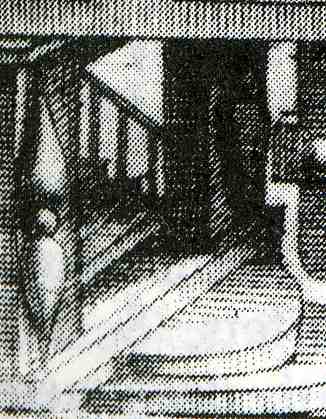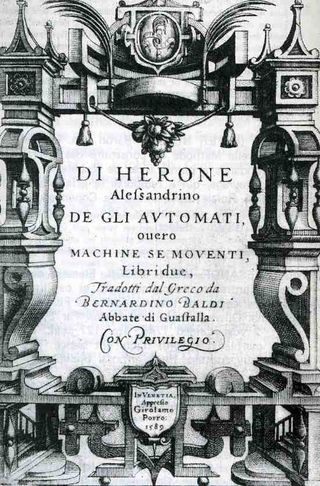JF Ptak Science Books LLC Post 356
 And so here we have a gorgeous title page for the very first treatise on automata, and the thing I'm focusing on are the stairs in the bottom corners of the design, the stairs that go nowhere. Maybe its just because of the seemingly flat effect of the perspective that they became so obvious to me, or the subtle sense of a twisted two-and-a-half dimensions feel to it, the very Escher-y feel of complex, impossible and improbable dimensionality. For example, the very pre-Baroque ornamentation of this very heavy title page construction seem to bounce between convex and concave, like the background and foreground change place somehow, as it the case of Escher's trying to find a place between planes of two- and three-dimensional representation. Although here I'm pretty sure the effect is unintentional; whereas in Escher, the effect is the aim of the art.
And so here we have a gorgeous title page for the very first treatise on automata, and the thing I'm focusing on are the stairs in the bottom corners of the design, the stairs that go nowhere. Maybe its just because of the seemingly flat effect of the perspective that they became so obvious to me, or the subtle sense of a twisted two-and-a-half dimensions feel to it, the very Escher-y feel of complex, impossible and improbable dimensionality. For example, the very pre-Baroque ornamentation of this very heavy title page construction seem to bounce between convex and concave, like the background and foreground change place somehow, as it the case of Escher's trying to find a place between planes of two- and three-dimensional representation. Although here I'm pretty sure the effect is unintentional; whereas in Escher, the effect is the aim of the art.
The design and the printing of this large book was the work of the firm of Bernardino Baldi, of Venice, who published De gli avtomati oueri machine se moventi...in Venice in 1589, the original by Her/Heron of Alexandria, who lived ca. 10-70 ACE. Hero was one of the most exalted of Greeks in the pantheon of ancient experimenters and scientists, an unparalleled inventor and producer of the earliest automatic and robotic devices. Have a look at the illustrated link to Hero's fabulous work called Penumatics (below).
Some of the works by (and attributed to) Hero include:
Automata, a description of machines which enable wonders in temples by mechanical or pneumatical means
Belopoeica, a description of war machines.
Catoptrica, about the progression of light, reflection and the use of mirrors.
Cheirobaalistr, about catapults.
Definitiones, containing definitions of terms for geometry.
Geometria, a collection of equations based on the first chapter of Metrica.
Metrica, a description of how to calculate surfaces and volumes of diverse objects.
Mechanica, preserved only in Arabic, written for architects, containing means to lift heavy objects.
On the Dioptra, a collection of methods to measure lengths.
Pneumatica, a description of machines working on air, steam or water pressure, including the hydraulis or water organ.
Stereometrica, examples of three dimensional calculations based on the second chapter of Metrica
The opening paragraph of Hero's Treatise on Pneutmatics (from the translated and online edition found HERE:
"A TREATISE ON PNEUMATICS. THE investigation of the properties of Atmospheric Air having been deemed worthy of close attention by the ancient philosophers and mechanists, the former deduciug them theoretically, the latter from the action of sensible bodies, we also have thought proper to arrange in order what has been handed down by former writers, and to add thereto our own discoveries : a task from which much advantage will result to those who shall hereafter devote themselves to the study of mathematics. We are further led to write this work from the consideration that it is fitting that the treatment of this subject should correspond with the method given by us in our treatise, in four books, on water-clocks. For, by the union of air, earth, fire and water, and the concurrence of three, or four, elementary principles, various combinations are effected, some of which supply the most pressing wants of human life, while others produce amazement and alarm."
.



Comments